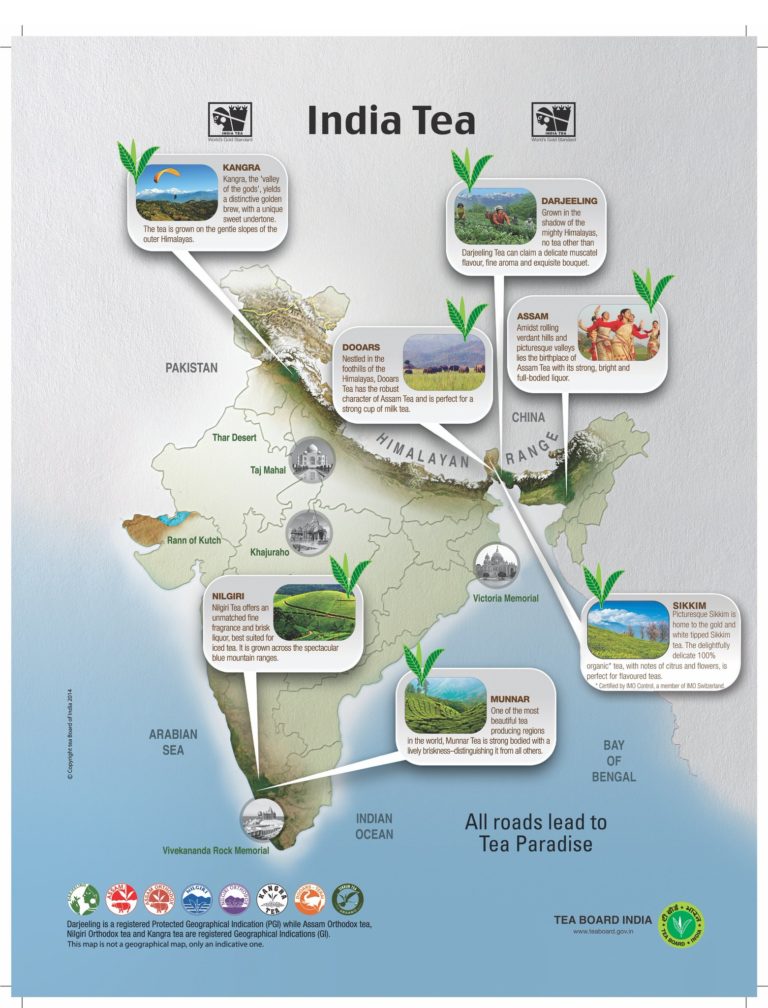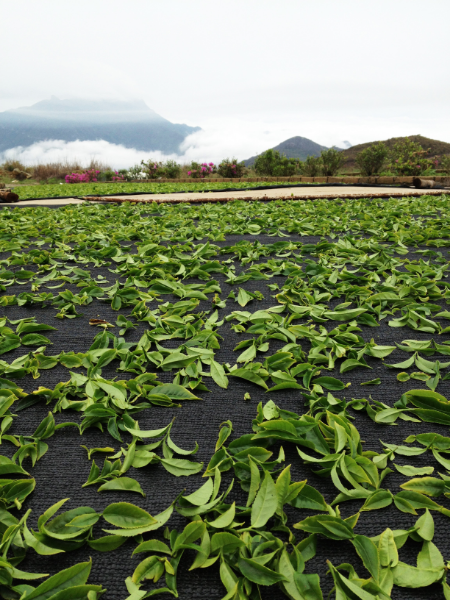A brief introduction to the seven major tea producing areas in India: Darjeeling, Assam, Kangra, Nilgiri, Dooars-Terai, Sikkim and Tripura
Darjeeling, Assam and Nilgiri are the three major areas where people talk about Indian tea areas. I like all the teas, but there are many other teas to explore! In this article, I will use the list of regions used by the Indian Tea Bureau. They are all awarded geographical indications by the World Trade Organization. Keep in mind that there are small manufacturers all over India, and not all manufacturers can fit into neat little boxes. Almost all the tea produced in India is black tea, but that is slowly changing. Darjeeling is arguably the most famous tea producer in India. In the 19th century, English colonists first planted tea in this area. The first tea trees planted here come from Robert Fortune's trip to China, and you can read the Tea Bandit for details. At present, there are 87 gardens in the area defined by geographical indications. The climate here is relatively cool because the tea here grows at a higher altitude. They are famous for their musk, especially the second red.

Assam is a low-altitude tea area in India, with hot and humid rainy seasons. Chinese plants growing in Darjeeling do not grow well in this climate. Robert Bruce is often thought to have found tea trees native to Assam. It had been used by Singaporeans for centuries before that encounter. Their traditional practice is to drain the tea first and then put it into a bamboo tube. The tea in this area is famous for its rugged and malt taste. For this reason, they are often used in breakfast style mixtures. There are about 800 tea gardens in Assam. NilgiriNilgiri is another high-altitude tea area. Its name means "Blue Mountain". Commercial tea cultivation began in 1845. After the independence of India, the Nilgiris family paid more attention to low-quality CTC tea. There are hundreds of tea gardens in this area, as well as thousands of small farmers who sell their harvest to the factories that buy tea. Nilgiri tea tastes balanced and active, but not as bold as Assam tea. The high-quality traditional tea here has my favorite citrus flavor. Congra Congra, known as the Valley of God, is a tea-producing area in the northwestern state of Himachal Pradesh, India. Tea production began in 1852, when all plants were grown in China. Tea production was seriously damaged in the 1905 earthquake, but it has gradually recovered since the 1960s. Next to a cooperative factory and some private tea gardens, there are about 6000 small farmers. 90% of the locally produced tea is traditional black tea. Kangla tea is lighter in color and less fragrant than Darjeeling Tea, but has a sweet aftertaste. After Dooars-Terai 's success in Darjeeling, farmers were encouraged to build a new estate in Duas-Terai. Terai is located in the foothills of Darjeeling, while Dooars is low above sea level and borders Bhutan. There are 300 tea gardens in the region, accounting for 20% of India's tea production. Most of the tea is ctc-style black tea. Duas-Terai's tea is bright in color and smooth in taste, slightly lighter than Assam, but still rich. Sikkim has less than 180 hectares of tea, which is the smallest geographical indication. It lies to the north of Darjeeling. Among them, Temi Tea Estate tea garden accounts for the majority, but local small farmers also began to grow tea. Sikkim tea is bright in color, slightly floral and sweet in aftertaste. It tastes very similar to the tea of its northern neighbors, so I often recommend it to those looking for cheaper alternatives. Tripla Bontripla is an interesting area because it is the only area that is not created by British planters. Its tea planting history can be traced back to 1916. There are about 54 tea gardens, 21 tea processing plants and more than 2500 small farmers. Tripla seems to keep a low profile, but they are the fifth-largest producer in India. Most of them are CTC black tea and a small amount of green tea. They are so little known outside India that I can't describe their taste! I hope this article will help you learn more about the tea producing areas of India. These are just short descriptions for you to start, but I encourage you to dig deeper. I have a feeling that as the demand for specialty tea increases, we will see some really interesting tea from India. Which is your favorite Indian tea producing area? You have found a new one. Would you like to try it?
Important Notice :
前街咖啡 FrontStreet Coffee has moved to new addredd:
FrontStreet Coffee Address: 315,Donghua East Road,GuangZhou
Tel:020 38364473
- Prev

What kind of tea is Dawuye? Where does the authentic Wuye Dancong tea come from? What's the taste of Wuyedan fir?
Wuye Dancong is a complex Phoenix oolong tea, which is called "Big Black Leaf" in English-speaking countries. This special type of Dan bushes is known for its highly aromatic, floral and sweet contours. It grew in Chaozhou, Guangdong, and was harvested in early April. This batch is the harvest of 2020. Single fir is a general term, it refers to oolong
- Next

How much does a stray cat charge in a nearby cat cafe when he works as a detective in a cafe to make a living?
Today, there is a cute hot search on Weibo: "A stray cat in Shanghai works as a detective in a cafe to make a living." I thought it was a hot cat coffee, but when I clicked in, I found that I went to the coffee shop to apply for a job to catch a mouse as a door god, which was not the same type as cat coffee at all. According to the Youth Daily, the official Weibo in October
Related
- What effect does Italian American coffee with filter paper have? Will coffee taste better if it is put on filter paper at the bottom of the powder bowl?
- What is the color difference in coffee beans? What are the characteristics of honey processed coffee beans? Why are the anaerobically treated coffee beans uneven in color?
- How does novice Xiaobai quickly get started and make coffee? Newbies learn to make coffee by hand and share the specific steps and process process!
- Costa tea has a shelf life of 100 years?! Expert: Unable to verify
- It's a huge uproar! American milk addition was rejected by Manner employees?!
- Mocha pot coffee bean recommendations| How fine and how much powder should be used for grinding? What parameter ratios do I need to use to make milk with Mocha pot coffee?
- What are the characteristics of the world's top ten coffee beans treated with Costa Rica honey? How to make black honey kadura from Tarazhu Pilon Processing Plant taste good?
- How to make deep-roasted coffee? What grinding water temperature does authentic Jamaica Blue Mountain No. 1 coffee use to brew it well?
- Selected high-grade rose summer coffee flavor tasting guide Why Panama rose summer has the aroma of flowers and fruits
- What equipment does a novice Xiaobai need to buy to learn to make coffee? Filter cup electronic scale bean grinder manual flushing pot purchase guide

